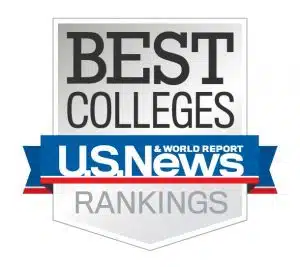The Top STEM Colleges in the Country
Career growth for science, technology, engineering, and mathematics (STEM), is expected to surge in the next decade. The U.S. Bureau of Labor Statistics predicts a 13% growth for STEM jobs in the next decade. STEM careers are becoming increasingly important as science and technology continue to advance.
While 45% of STEM jobs are computer-based, several STEM careers focus on engineering, life sciences, and mathematics. Students interested in a STEM career can find a variety of fulfilling job opportunities.
The U.S. Bureau of Labor Statistics predicts that career growth in Architecture and Engineering, Life, Physical and Social Science, and Computers and Mathematics will explode in the next few years.

Equally important as job growth is education and students need to be well prepared to tackle these innovative and life-changing careers. There are a variety of STEM majors and programs that students can choose from.
The tricky part is choosing the program that best fits your career goals. College options include everything from specialized institutions to larger research universities and everything in-between.
STEM colleges include a broad range of courses, from aerospace studies to marine biology, so finding the right STEM focus may take time for some students.
It’s important to find a STEM college program that offers a variety of studies, exposing students to the variety of available STEM careers. Here is a list of the top STEM colleges and universities in the U.S.
1. Massachusetts Institute of Technology (MIT) – Cambridge, MA
Consistently ranked as the best engineering school in the country, the Massachusetts Institute of Technology is home to some of the brightest minds in the world. With close to 20 research centers on campus, MIT students study a variety of topics including ocean engineering, cancer research, and nanotechnology.
MIT prides itself on educating its students through action, so students learn through a service to society framework. This means that students are encouraged to collaborate with faculty to create solutions to global challenges.
Founded in 1861, MIT is one of the STEM colleges whose commitment to technological advancement has been since the industrial revolution. MIT offers degrees in aeronautics and astronautics, electrical engineering and computer science, and nuclear science and engineering, among other choices.
2. California Institute of Technology – Pasadena, CA
Founded in 1891, the California Institute of Technology, also known as Caltech, is one of the top schools in the country. Ranked #9 nationally by “U.S. News & World Report,” Caltech is a world-renowned private institution conveniently positioned in the outskirts of Los Angeles, CA.
The institute manages NASA’s Jet Propulsion Laboratory (JPL) in addition to NASA-owned telescopes like NuSTAR, Planck, Spitzer, and Galex.
Caltech also receives research grants from institutions like the National Science Foundation and the Department of Health and Human Services, for research purposes.
Caltech is a smaller institution compared to other STEM colleges on this list, so students can work closely with faculty on research projects.
3. Stanford University – Stanford, CA
Stanford University has developed a reputation as a leading STEM field due to its focus on making this popular field accessible to everyone.
In fact, the school has a dedicated Office of STEM Outreach (OSO) that focuses entirely on connecting people with STEM academic opportunities to increase “engagement, participation, equity, and inclusion in STEM fields.”

On top of that, Stanford hosts dozens of STEM-related programs each year in which undergraduate students and even some high schoolers can participate to further their development in the field.
These are excellent opportunities for those students looking to increase their knowledge and development outside of the classroom. You can see the latest programs here.
4. Princeton University – Princeton, NJ
Princeton has committed itself to create a culture of support and engagement for students seeking to pursue a degree in the STEM field.
The focus of this liberal arts college is to build a climate of STEM equity, access, and excellence by engaging administrators, students, and faculty members to create the best undergraduate STEM experience possible.
Undergraduate students can choose from countless different STEM-related classes to put towards a respectable number of STEM-related majors ranging from science and technology fields to engineering and math. For example, Princeton’s engineering department is further split into the following areas:
- Chemical and Biological Engineering
- Civil and Environmental Engineering
- Computer Science
- Electrical and Computer Engineering
- Mechanical and Aerospace Engineering
- Operations Research and Financial Engineering
- Andlinger Center for Energy and the Environment
- Center for Information Technology Policy
- Keller Center for Innovation in Engineering Education
- Princeton Institute for the Science and Technology of Materials
5. Harvard University – Cambridge, MA
It’s no surprise to see Harvard University on this list. With the reputation of being the best university in the world, Harvard excels at everything it offers – including STEM majors.
According to the university, STEM education is essential for building “21st-century competencies” including collaboration, problem-solving, creativity, and critical thinking.
The STEM fields at Harvard are designed to prepare students for the labor market of the future while equipping them with the skills they need to succeed.
Given the broad context of Science, Technology, Engineering, and Math fields, there are countless ways Harvard undergraduates can achieve a degree in this subject matter.
There are various STEM departments, majors, concentrations, and majors. The pathway you choose will be determined largely by your field of interest. No matter what you choose, Harvard will help you succeed in this field.
6. UC Berkeley – Berkeley, CA
UC Berkeley lives up to its reputation as one of the best liberal arts colleges in the country by providing a rigorous curriculum for students interested in the STEM field. Some of the STEM-related departments students can enter include:
College of Chemistry
- Chemical Engineering
- Chemistry Departments
The Division of Computing, Data Science & Society
- School of Information
- Departments of Electrical Engineering
- Computer Sciences and Statistics
- Berkeley Institute for Data Science
- Center for Computational Biology
The College of Engineering
- Bioengineering
- Civil & Environmental Engineering
- Electrical Engineering & Computer Sciences
- Industrial Engineering & Operations Research
- Materials Science & Engineering
- Mechanical Engineering
- Nuclear Engineering
The School of Information
Letters & Science
As the largest college at UC Berkeley, it includes over 60 different departments in the social sciences, biological sciences, physical sciences, and arts and humanities.
The Rausser College of Natural Resources
- Agricultural and Resource Economics
- Environmental Science, Policy, and Management
- Nutritional Science
- Plant and Microbial Biology
7. Carnegie Mellon University – Pittsburgh, PA
Carnegie Mellon University is a leading global research university renowned for its engineering, computing, and science programs as well as its emphasis on interdisciplinary education which fits perfectly into the diversity of the STEM field. The College of Engineering is ranked highly when compared with similar programs due to its cross-disciplinary research and emphasis on collaboration.

The Mellon College of Science and the Department of Mathematical Sciences share similar accolades. Between these STEM-related departments, students won’t have any trouble finding a robust education.
The world-class instructors at Carnegie Mellon ensure that any section of their STEM-related curriculum will challenge students and provide them with the skills, insights, and knowledge they need to succeed in the professional world.
8. Harvey Mudd College – Claremont, CA
Despite not being as well known as some of the other west coast science and engineering colleges, Harvey Mudd deserves a spot on the list of the best STEM colleges in the country. It offers a wide range of STEM-related majors through its seven academic departments:
- Biology
- Chemistry
- Computer Science
- Engineering
- Humanities, Social Sciences, and the Arts
- Mathematics
- Physics
Harvey Mudd’s focus on STEM education extends far beyond its campus with its Women’s Inclusion in Science, Technology, Engineering & Mathematics (WISTEM) initiative which seeks to increase the number of women in the STEM fields.
9. University of California – San Diego, CA
Unlike many of the other STEM colleges mentioned on this list, the University of California-San Diego offers a unique STEM educational focus. Here, marine biology is a large focus for this prestigious research university.
Due to its location in San Diego, and its proximity to the ocean, UCSD is the perfect institution for students interested in studying marine biology and oceanography.
Students frequently learn through field trips to intertidal zones, salt marshes, and other marine ecosystems to attain a firsthand educational experience.

Initially established as the Scripps Institution of Oceanography in 1909, the school became a full university in 1960.
Now the university boasts 11 colleges and course work in various fields including the physical and biological sciences, engineering, and medicine. UCSD is also home to a nationally ranked pharmaceutical sciences program.
10. Rice University – Houston, TX
A private institution founded in 1912, Rice University is a top-ranked university nestled in the heart of Houston’s Museum District. The university has a special concentration in applied sciences and research as evidenced by three of its 8 schools being devoted to STEM colleges.
The George R. Brown School of Engineering, the School of Architecture, and the Wiess School of Natural Sciences offer students more than 50 undergraduate majors with opportunities for further research and collaboration outside of the classroom. Rice University offers majors in areas such as:
- Chemical and Biomolecular Engineering
- Materials Science and Nanoengineering
- Bioengineering
- Civil and Environmental Engineering
- Earth, Environmental and Planetary Sciences
11. Georgia Institute of Technology – Atlanta, GA
One of the best technical and research institutions in the nation, Georgia Institute of Technology ranks #38 by the “U.S. News & World Report.” With a rich history dating back to 1885, this renowned public institution is one of the most well-known research institutions in the US.
The highly ranked College of Engineering and Scheller College of Business is highly ranked nationally. The Georgia Tech Research Institute carries on industry and government research for the Georgia Research Alliance.
Georgia Tech prides itself on being a national leader in shaping the economic shift from industry to information and technology.
This STEM college offers degree programs in areas such as engineering and business, computational media, biomedical engineering, biotechnology, and aerospace engineering.
Tips for getting into a top STEM college.
If you already know that a degree in the STEM field is what you want to study in college, you’re already farther than three-fourths of students who have no idea what they want to study or who will change their mind at least once…and, many times, even more.

Now, the question is how to get into these top STEM colleges. There are steps you can start taking in high school to help increase your chances of getting admitted into these prestigious colleges and universities. Here are a few:
Take STEM courses in high school.
By definition, STEM is a multidisciplinary field. As many of you might already know, STEM stands for Science, Technology, Engineering, and Math. There are many high school courses that fall under this large umbrella which is good news for students who are seeking to pursue a degree in this field.
This next point might sound obvious, but it’s definitely worth mentioning. Students interested in STEM majors should take as many STEM courses in high school as reasonably possible. What does that mean exactly?
Well, you can’t only take STEM classes, nor should you. Plus, you don’t want to take so many that your grades end up slipping. It’s not easy getting into college with a low GPA. High schoolers need to find that happy medium of challenging themselves with tough STEM courses while still getting excellent grades.
Taking Advanced Placement (AP) and honors STEM courses is an excellent choice. Admissions officers love to see students who push themselves by taking college-level courses. Plus, many of these classes have weighted GPAs which can help average out to better academic performance overall.
Participate in STEM-related extracurriculars.
GPA and academic performance are a fundamental part of the college admissions process. However, high schoolers shouldn’t underestimate the influence of extracurricular activities on their chances of getting into their top-pick schools. Admissions officers want to see that students are succeeding in and outside of the classroom.
One of the best areas to display your prowess and eagerness in the STEM field is by participating in related activities.
These could be clubs at school, local competitions, quizzes and tests, summer programs, internships, or anything else that takes place out of school. The key is finding something you enjoy that’s related to the STEM field.
Committing your free time to increase your knowledge in the field and developing new skills and abilities looks great on your application. It shows colleges and universities that you’re serious about pursuing a degree in the STEM field. Here are some excellent STEM-related extracurriculars to consider participating in.
First Competitions
“Combining the excitement of sport with the rigors of science and technology.“
Elementary, middle & high school
Botball
“Educational Robotics Program that engages middle and high school students in a team-oriented robotics competition.”
Vex Robotics Competition
“The largest and fastest-growing middle and high school robotics program globally with over 20,000 teams from 50 countries playing in over 1700 competitions worldwide.”
Zero Robotics
“A robotics programming competition where the robots are SPHERES (Synchronized Position Hold Engage and Reorient Experimental Satellites) inside the International Space Station.“
Congressional App Challenge
“The Congressional App Challenge is transforming how Congress views computer science and STEM.”
STEM Video Game Challenge
“The challenge was launched in September of 2010 at the White House by President Obama.”
Middle & high school
Science Olympiad
“Science Olympiad competitions are like academic track meets, consisting of a series of 23 team events in each division.”
Genius Olympiad
“GENIUS Olympiad promotes a global understanding of environmental issues and the achievement of sustainability through basic science, arts, creative writing, engineering, design, and business development.”
National Ocean Sciences Bowl
“The NOSB is an academic competition and program that addresses a national gap in environmental and earth sciences in public education by introducing high school students to and engaging them in ocean science, preparing them for ocean science-related and other STEM careers, and helping them become knowledgeable citizens and environmental stewards.“
Google Science Fair
“Students submit a project in which science is used to help change the world. “
Junior Science and Humanities Symposium
“Students compete for scholarships and recognition by presenting results of their STEM projects to a panel of judges.”
Intel International Science and Engineering Fair
“Through a global network of local, regional and national science fairs, top students are selected from millions, all who have demonstrated their knowledge of science and engineering to further their understanding of the world and improve the way we work and live.”
Modeling the Future Challenge
“To compete, students conduct their own research project modeling real-world data to analyze risks and make recommendations to companies, industry groups, governments, or organizations.”
Harvard-MIT Mathematics Tournament
“Founded in 1998, HMMT is one of the largest and most prestigious high school competitions in the world. Each tournament draws close to 1000 students from around the globe, including top scorers at national and international olympiads.”
Focus on all of your academic subjects.
When you’re positive about what degree to pursue in college, you might be tempted to focus all of your attention on classes related to that field. For example, as an aspiring STEM-degree holder, you might want to commit fully to Science, Technology, Engineering, and Math classes while letting other courses fall by the wayside.
This is a risky bet and ill-advised since admissions officers look at your entire academic performance, not just classes related to your intended major.
So, hypothetically speaking, a student who received a 4.0 average in STEM classes but barely passed all other courses might have a harder time getting accepted than a student who did just above-average in all courses.
It’s important to strive for high academic performance across the board. It not only shows colleges that you’re a well-rounded student, but it also demonstrates your ability to stay organized, focused, determined, and consistent – all qualities that will help you in college.
Work with a college admissions specialist.
One of the most effective ways to get a spot in a competitive STEM program is by working with a college admissions professional. These experts can help you perfect your application to increase your odds of getting accepted to your top-pick school.
With in-depth knowledge of the admissions process and real-world experience helping high schoolers succeed in this endeavor, a college entrance expert can help you with a variety of important decisions such as choosing the best high school courses, summer programs, extracurricular activities, and a wide range of other critical factors.
Many high schoolers are intrigued by a career in the STEM fields without fully understanding where to put their energy most efficiently for a smooth move into college.
A college admissions expert is like a personal advisor who can answer all of your college-related questions and help you achieve your college goals.
Interested in working with an experienced and highly knowledgeable admissions expert? Contact AdmissionSight today to learn more about what we offer.





































